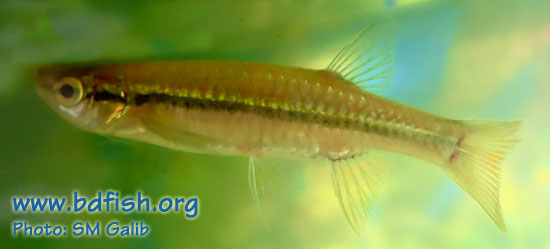
Systematic position
Phylum: Chordata
Class: Actinopterygii (Ray-finned fishes)
Order: Cypriniformes (Carps)
Family: Cyprinidae (Minnows or carps)
Subfamily: Rasborinae (= Danioninae)
Genus: Esomus
Species: E. danricus
Common/local names
English: Flying barb
Bangladesh: Darkina (দারকিনা), Darki (দারকি) and Darkya (দারক্যা)
India: Darikana (Assam); Dadhikha, Danrika and Jongia (West Bengal); Kurriahdehwiee, Soomarah and Dendu (Bihar and Uttar Pradesh); Chiddullu and Chilwa (Punjab); Jhai (Orissa); Astapakke (Andhra Pradesh); Messaparavai, Ovari-kendai and Purrovoo (Tamil Nadu) and Meesa-parava (Kerala) (Talwar and Jhingran, 1991).
Distributions: Bangladesh. Also in Pakistan (Punjab and Sind Provinces), India, Nepal and probably in Sri Lanka and Myanmar (Talwar and Jhingran, 1991).
Conservation status: Data Deficient in Bangladesh (IUCN Bangladesh, 2000).
Synonyms
Cyprinus jogia Hamilton, 1822
Cyprinus sutiha Hamilton, 1822
Esomus danrica grahami (Chaudhuri, 1912)
Esomus danricus jabalpurensis Rao & Sharma, 1972
Esomus jogia (Hamilton, 1822)
Esomus lineatus Ahl, 1923
Esomus sutiha (Hamilton, 1822)
Esomus vittatus Swainson, 1839
Leuciscus vittatus Swainson, 1839
Nuria danrica (Hamilton, 1822)
Nuria danrica grahami (Chaudhuri, 1912)
Nuria thermophilos (McClelland, 1839)
Perilampus macrouru McClelland, 1839
Perilampus macrourus McClelland, 1839
Perilampus recurvirostris McClelland, 1839
Perilampus thermophilus McClelland, 1839
Morphology: Body elongate and compressed laterally with pointed head. Lower jaw longer. Body depth 3.3-4.8 times in SL and head length 3.5-5 times in SL (Talwar and Jhingran, 1991). Mouth small and 2 pairs of barbels of which maxillary pair is extremely long reaching middle of the body. Pectoral long and pointed. Lateral line incomplete. 29-32 (Rahman, 1989 and 2005); 27-30(Talwar and Jhingran, 1991) scales in longitudinal series.
Body color olive-green to gray-green. A broad dark lateral band from mouth to caudal base. In juvenile, this band is bordered by a fine gold stripe (Talwar and Jhingran, 1991). Pelvic reddish and other fins are brownish to orange.
Fin formula:
D. 8 (2/6); P1. 11-13 (1/10-12); P2. 7 (1/6); A. 7-8 (2-3/5) (Rahman, 1989 and 2005)
D ii 6; A iii 5; P i 14-15; V i 6-7 (Talwar and Jhingran, 1991)

Maximum lengths: 6 cm (Rahman, 1989 and 2005) and 12.5 cm (Talwar and Jhingran, 1991).
Habitats: Inhibits ponds and weedy ditches (Talwar and Jhingran, 1991). Found in small streams, ponds, ditches, beels and inundated fields; abundant during rainy season (Rahman, 1989 and 2005).
Recorded from the Bookbhara baor in Jessore (Mohsin et al., 2009); Chalan beel (Galib et al., 2009 and 2010); Padma river in Rajshahi (Samad et al., 2010).
Fishery info: Used as food fish in Bangladesh. Consumed mainly by the lower class consumers (Samad et al., 2010).
__________________________________________________________
REFERENCES
Ahl E (1923) Eine Revision der Cypriniden-Gattung Esomus. In: Ichthyologische Mitteilungen, IV. Mitteilungen aus dem Zoologischen Museum in Berlin 11 (1): 38-43.
Chaudhuri BL (1912) XXXV. Descriptions of some new species of freshwater fishes from north India. Records of the Indian Museum (Calcutta) v. 7 (pt 5): 437-444, Pls. 38-41.
Galib SM, Samad MA, Hossain MA, Mohsin ABM and Haque SMM (2010) Small Indigenous Species of Fishes (SISF) in Chalan Beel with Reference to their Harvesting and Marketing, Bangladesh Journal of Progressive Science and Technology, 8(2): 251-254.
Galib SM, Samad MA, Mohsin ABM, Flowra FA and Alam MT (2009) Present Status of Fishes in the Chalan Beel- the Largest Beel (Wetland) of Bangladesh, Int. J. Ani. Fish. Sci. 2(3):214-218.
Hamilton F (1822) An account of the fishes found in the river Ganges and its branches. Edinburgh & London. An account of the fishes found in the river Ganges and its branches.: i-vii + 1-405, Pls. 1-39.
IUCN Bangladesh (2000) Red book of threatened fishes of Bangladesh, IUCN- The world conservation union. xii+116 pp.
McClelland J (1839) Indian Cyprinidae. Asiatic Researches 19(2): 217-471, Pls. 37-61.
Mohsin ABM, Hasan MM and Galib SM (2009) Fish Diversity of Community Based Fisheries Managed Oxbow Lake (Bookbhara Baor) in Jessore, Bangladesh, J. Sci. Foundation 7(1): 121-125.
Rahman AKA (1989) Freshwater Fishes of Bangladesh, 1st edition, Zoological Society of Bangladesh, Department of Zoology, University of Dhaka, Dhaka-1000, pp. 82-83.
Rahman AKA (2005) Freshwater Fishes of Bangladesh, 2nd edition, Zoological Society of Bangladesh, Department of Zoology, University of Dhaka, Dhaka-1000, pp. 99-100.
Rao VV and Sharma HS (1972) Esomus danricus jabalpurensis subsp. nov. from Pariat River near Jabalpur. Journal of the Bombay Natural History Society 69(2): 434-436.
Swainson W (1839) The natural history and classification of fishes, amphibians, & reptiles, or monocardian animals. Spottiswoode & Co., London. Nat. Hist. & Class. i-vi + 1-448.
Talwar PK and Jhingran AG (1991) Inland Fishes of India and Adjacent Countries, Vol. 1, Oxford & IBH Publishing Co. Pvt. Ltd. New Delhi-Calcutta, pp. 377-378.
Visited 3,841 times, 1 visits today | Have any fisheries relevant question?
